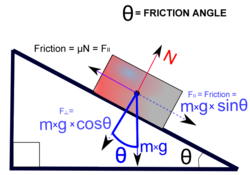Physics:Constraint (classical mechanics)
From HandWiki
Short description: Parameter which a physical system must obey
In classical mechanics, a constraint on a system is a parameter that the system must obey. For example, a box sliding down a slope must remain on the slope. There are two different types of constraints: holonomic and non-holonomic.[1]
Types of constraint
- First class constraints and second class constraints
- Primary constraints, secondary constraints, tertiary constraints, quaternary constraints.
- Holonomic constraints, also called integrable constraints, (depending on time and the coordinates but not on the momenta) and Nonholonomic system
- Pfaffian constraints
- Scleronomic constraints (not depending on time) and rheonomic constraints (depending on time).
- Ideal constraints: those for which the work done by the constraint forces under a virtual displacement vanishes.
References
- ↑ Leach, Dr Andrew (2001-01-30) (in en). Molecular Modelling: Principles and Applications (2nd ed.). Harlow: Prentice Hall. pp. 369–370. ISBN 9780582382107. https://www.amazon.co.uk/Molecular-Modelling-Applications-Andrew-Leach/dp/0582382106/ref=sr_1_1?ie=UTF8&qid=1518083220&sr=8-1&keywords=molecular+modelling+principles+and+applications.
fa: دستگاههای مقید


